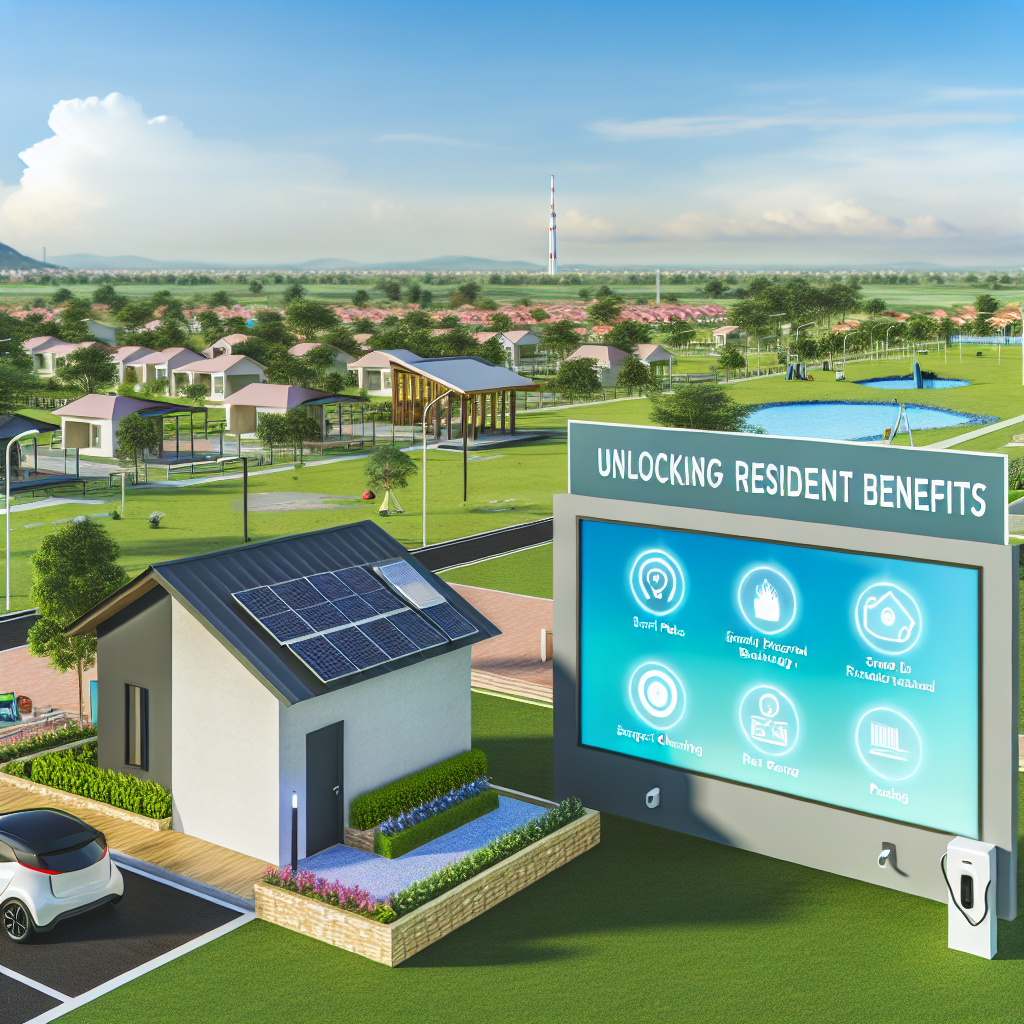Maximizing Resident Benefits: Innovative Community Amenities for Enhanced Tenant Experience in 2025
As we approach 2025, the landscape of residential living is undergoing a transformative shift, driven by the integration of smart solutions designed to enhance tenant experiences and maximize resident benefits. This evolution is not merely a trend but a response to the growing demand for convenience, sustainability, and community engagement within residential communities. The focus is increasingly on creating environments that not only meet the basic needs of residents but also enrich their quality of life through innovative amenities and services.
One of the most significant advancements in this realm is the incorporation of smart home technologies. These technologies are becoming a staple in modern residential communities, offering residents unprecedented control over their living environments. From smart thermostats that optimize energy usage to intelligent lighting systems that adapt to individual preferences, these innovations contribute to both comfort and cost savings. Moreover, the integration of voice-activated assistants and smart security systems enhances safety and convenience, allowing residents to manage their homes with ease and peace of mind.
In addition to individual unit enhancements, community-wide smart solutions are playing a pivotal role in fostering a sense of belonging and engagement among residents. For instance, the implementation of app-based platforms that facilitate communication between residents and property management is revolutionizing the way communities operate. These platforms enable residents to report maintenance issues, reserve communal spaces, and participate in community events with just a few taps on their smartphones. Consequently, this seamless interaction not only streamlines operations but also strengthens the sense of community by encouraging active participation and collaboration.
Furthermore, the emphasis on sustainability is reshaping the amenities offered within residential communities. As environmental consciousness continues to rise, developers are prioritizing eco-friendly solutions that align with the values of modern residents. This includes the installation of solar panels, electric vehicle charging stations, and community gardens that promote sustainable living practices. By providing these green amenities, residential communities are not only reducing their carbon footprint but also attracting environmentally conscious tenants who value sustainable living.
Another noteworthy trend is the creation of multifunctional communal spaces that cater to the diverse needs of residents. These spaces are designed to be adaptable, serving as co-working areas, fitness centers, or social hubs depending on the time of day and the preferences of the community. By offering flexible spaces that accommodate various activities, residential communities are enhancing the overall living experience and fostering a vibrant, dynamic environment where residents can connect and thrive.
Moreover, the integration of wellness-focused amenities is becoming increasingly prevalent, reflecting a broader societal shift towards health and well-being. From on-site fitness classes and wellness workshops to meditation gardens and walking trails, these amenities are designed to support the physical and mental health of residents. By prioritizing wellness, residential communities are not only improving the quality of life for their residents but also creating a more attractive living environment that appeals to a wide range of individuals.
In conclusion, the future of residential living is being shaped by smart solutions that enhance tenant experiences and maximize resident benefits. Through the integration of advanced technologies, sustainable practices, and wellness-focused amenities, residential communities are evolving into vibrant, engaging environments that cater to the diverse needs of modern residents. As we move towards 2025, these innovations will continue to redefine the standards of community living, offering residents a more convenient, connected, and fulfilling lifestyle.
Elevating Community Value: Smart Property Perks and Convenient Living Solutions for Modern Residents
As we approach 2025, the landscape of residential living is undergoing a transformative shift, driven by the integration of smart technologies and innovative solutions designed to enhance community value and improve the quality of life for modern residents. This evolution is not merely a trend but a response to the growing demand for convenience, sustainability, and connectivity within residential communities. By embracing these advancements, property developers and managers are not only elevating the living experience but also increasing the overall value of their communities.
One of the most significant benefits of smart property solutions is the enhancement of security and safety for residents. Advanced surveillance systems, smart locks, and integrated security platforms provide a robust framework that ensures peace of mind. These technologies allow for real-time monitoring and control, enabling residents to manage access to their homes remotely and receive instant alerts in case of any security breaches. Consequently, this level of security fosters a sense of trust and comfort, which is invaluable in community living.
In addition to security, smart technologies are revolutionizing energy management within residential communities. With the increasing emphasis on sustainability, energy-efficient solutions such as smart thermostats, automated lighting systems, and solar panels are becoming standard features. These innovations not only reduce the carbon footprint of residential properties but also lead to significant cost savings for residents. By optimizing energy consumption, these technologies contribute to a more sustainable living environment, aligning with the global push towards eco-friendly practices.
Moreover, the integration of smart home devices and platforms is enhancing the convenience and comfort of daily living. Voice-activated assistants, smart appliances, and home automation systems allow residents to control various aspects of their homes with ease. From adjusting the temperature and lighting to managing household chores, these technologies simplify everyday tasks, providing residents with more time to focus on what truly matters. This seamless integration of technology into daily life is a testament to the evolving expectations of modern residents who prioritize efficiency and convenience.
Furthermore, the concept of community living is being redefined through the implementation of shared amenities and services powered by smart solutions. Co-working spaces, fitness centers, and communal areas equipped with high-speed internet and smart devices are becoming integral parts of residential communities. These shared spaces not only foster social interaction and collaboration among residents but also enhance the overall sense of community. By providing access to these amenities, property developers are creating environments that support both personal and professional growth, thereby increasing the appeal of their communities.
In addition to physical amenities, digital platforms are playing a crucial role in enhancing community engagement and communication. Mobile apps and online portals allow residents to connect with each other, participate in community events, and access important information with ease. These platforms facilitate seamless communication between residents and property management, ensuring that any issues or concerns are addressed promptly. This level of connectivity strengthens the community bond and promotes a harmonious living environment.
As we look towards 2025, it is evident that the integration of smart solutions in residential communities is not just an enhancement but a necessity. By prioritizing security, sustainability, convenience, and community engagement, property developers and managers are setting new standards for modern living. These advancements not only elevate the value of residential properties but also enrich the lives of residents, creating communities that are well-equipped to meet the demands of the future.
Revolutionizing On-Site Trash Management: A Key to Improved Community Living and Resident Satisfaction in 2025
As we approach 2025, the landscape of community living is undergoing a significant transformation, driven by innovative solutions that aim to enhance resident satisfaction and overall quality of life. Among these advancements, the revolutionization of on-site trash management stands out as a pivotal development. This evolution is not merely about improving waste disposal efficiency; it is about creating a more harmonious and sustainable living environment that benefits both residents and property managers alike.
Traditionally, waste management in residential communities has been a cumbersome process, often plagued by inefficiencies and inconveniences. Residents have long been accustomed to the routine of hauling trash to centralized collection points, a task that can be both time-consuming and unpleasant. Moreover, these collection points can become unsightly and odorous, detracting from the aesthetic appeal of the community. However, with the advent of smart waste management solutions, these challenges are being addressed in innovative ways.
One of the key components of this transformation is the integration of technology into waste management systems. Smart bins equipped with sensors are being deployed to monitor waste levels in real-time. These sensors provide valuable data that can be used to optimize collection schedules, ensuring that bins are emptied only when necessary. This not only reduces the frequency of waste collection trips, thereby lowering operational costs and carbon emissions, but also prevents the overflow of waste, which can lead to unsanitary conditions.
Furthermore, the implementation of automated waste collection systems is gaining traction. These systems utilize underground vacuum networks to transport waste from individual units to a central collection point. By eliminating the need for residents to manually dispose of their trash, these systems enhance convenience and reduce the potential for littering. Additionally, they contribute to a cleaner and more visually appealing community environment, which can significantly boost resident satisfaction.
In addition to technological advancements, there is a growing emphasis on promoting sustainable waste management practices within communities. Educational initiatives aimed at encouraging recycling and composting are being introduced, fostering a culture of environmental responsibility among residents. By providing clear guidelines and easy access to recycling facilities, communities can significantly reduce their environmental footprint while also instilling a sense of pride and ownership among residents.
Moreover, the benefits of improved waste management extend beyond environmental considerations. Enhanced waste management systems can lead to increased property values and attract prospective residents who prioritize sustainability and convenience. Property managers, in turn, benefit from reduced maintenance costs and improved tenant retention rates, creating a win-win situation for all stakeholders involved.
As we look towards 2025, it is clear that the revolutionization of on-site trash management is a key component of enhancing community living. By leveraging technology and promoting sustainable practices, residential communities can create a more pleasant and efficient living environment. This not only improves the quality of life for residents but also contributes to the long-term success and sustainability of the community as a whole. As these smart solutions continue to evolve, they hold the promise of transforming the way we think about waste management, paving the way for a cleaner, more sustainable future.
Discover the future of community living with our Resident Benefits & Community Living Enhancement: Smart Solutions for 2025. Embrace innovation and elevate your lifestyle today! Learn more.



